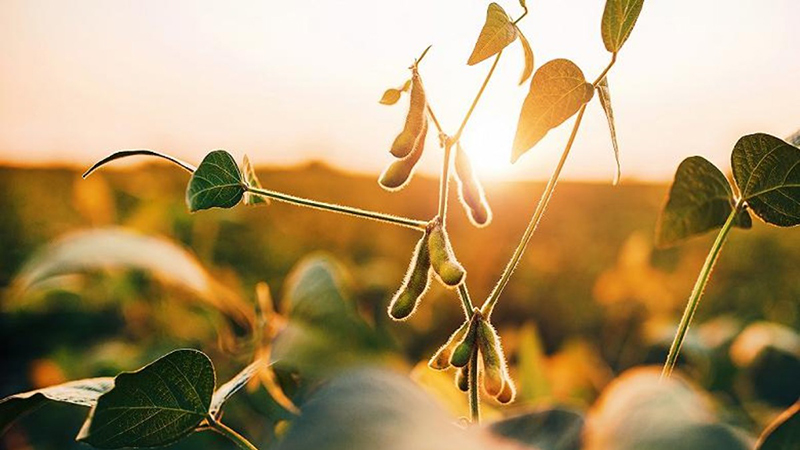Scrutiny on South America’s soy crop intensifies amid dry weather

It’s dry in Argentina, Paraguay and the southern states of Brazil, so market watchers are going to be paying close attention in the weeks and months to come as South American soybean crops are harvested. U.S. soybean prices are strong on the heels of recent slashes to production forecasts for all three South American countries.
It’s still early in the year and Brazil has only just begun to harvest. But La Niña-fueled dryness could prompt analysts in North America and South America to cut forecasts further, spurring increased prices for U.S. farmers.
“A lot of this is predicated on extended dryness across much of southern Brazil, which is impacting Argentina and Paraguay as well because they are in the center of where we see the La Nina impact coming this year – the second La Niña in a row,” says Mac Marshall, vice president of market intelligence at the United Soybean Board and U.S. Soybean Export Council.
USDA last week cut its forecast for Brazilian soybean production by 5 million metric tons, reduced its prediction for Argentine production by 3 million tons and dropped its prediction for Paraguay by 1.5 million tons.
“It’s pretty rare for USDA to make cuts to the Brazilian crop in January. Usually, the adjustments come later in the year,” Marshall said.
While most analysts point to the extended dryness in southern Brazil, USDA’s Foreign Agricultural Service also stresses that heavy rains in the center and northeast are also impacting crops. The FAS office in Brasilia is now predicting Brazilian soybean production this year at 136 million tons. That’s lower than the forecast of 139 million tons out of USDA’s Washington headquarters. Both are down from previous forecasts of 144 million tons.
“Paraguay was staggering in percentage terms because last month the estimate was for 10 million tons and now that’s down to 8.5 million tons,” Marshall said. “You put all those together and it knocks a substantial amount off the balance sheet.”
The cuts to South America’s crop helped push the March future price of U.S. soybeans to $14 per bushel and the November price to $13 briefly last week.
Brazil, the largest soybean-producing country in the world, has the largest impact on global supply, and drought is slashing estimates for its two southernmost states – Paraná and Rio Grande do Sul. Neither is as large as the biggest producing state of Mato Grasso, but together, the two produce about 30% of Brazil’s soybeans.
Brazil’s harvest is less than 2% complete, but damage in the south is expected to be substantial, Brazilian consulting firm AgRural said this week. In Rio Grande do Sul, where farmers have not yet begun to bring in their soybeans, “the intense heat of the last few days has worsened the situation of the crops and the producers anxiously await the confirmation of the rain forecasts.”
The newly released USDA forecast for Brazilian soybean production would still be a record year for the country, but that’s not the case for some local forecasts, such as AgRural. The firm, which is headquartered in Paraná, has reduced its forecast to just 133.4 million tons, down from a previous forecast of 145.4 million tons.
“It’s not like there aren’t potential pitfalls. Over the last decade more often than not … the final crop size for Brazil has been larger than what the January (USDA) estimate has been. If we look over the last 11 marketing years, we’ve had five seasons of La Niña impacting South America. In four of those instances, you had the January estimate underestimate the Brazilian crop. All this is to say right now we’re seeing markets respond to those cuts … but down the line there’s potential that you could see an upside on the Brazilian crop later in the season.”
But John Payne, an analyst for Stone X and publisher of the Week in Grain, says he expects South American production cuts to deepen.
“You could see it get worse,” Payne said. “I don’t think you’re going to see it get better.”
And for U.S. farmers, that’s likely a positive factor.
“Bad production is always good for price, especially when you have a market like Brazil, which satisfies half of the global demand,” he said.
The cuts to forecasts for South American production this year could wind up closer to 20 million tons, he said, and that means U.S. farmers would likely increase plantings this spring – so long as demand from China remains strong.
“We have a failure of trend yields in South America,” Payne said. “This is adjusting the need for supply from elsewhere. The U.S. farmer is going to be depended on to grow more this summer.”
Read also
MARKET SIGNALS TO WATCH, June 20 – 27, 2025
Export duty back on the table: Ukraine revisits 10% tariff on soy and rapeseed
Global Trade in Focus: What’s Ahead for Grains & Oils in 2025/26?
India’s palm oil imports jump 61% in June to hit 11-month high
Ukrainian farmers are approaching the harvest of the first million tons of grain o...
Write to us
Our manager will contact you soon



